
In the 1990s, when India was pursuing economic reforms, testing nuclear weapons and raising its profile internationally, its defence establishment began work on a homegrown military jet engine: the Kaveri, named after a river in the country’s south.
For a nation where self-reliance in industry is a mantra of both Narendra Modi’s government and those that preceded it, the ability to develop and build such powerful technology on its own soil — referred to in India as an “indigenous” product — is one of its biggest dreams.
But producing advanced fighter jet engines is a complex process and the knowledge to make them requires real-world experience built up over decades. Only five countries — notably the current permanent members of the UN Security Council — know how to build them: the US, UK, France, Russia and China. Beijing, however, is just moving from a reliance on imported equipment from Russia and only recently test flew a fighter jet with a supposedly homegrown engine.
India was eager to join the elite club. But despite years of research, prototyping and testing, the Kaveri flopped. India had failed to produce an engine with sufficient thrust to power its current generation of Tejas light combat aircraft. Instead, it plans to use a version of the Kaveri in future unmanned aerial vehicles (UAVs), or drones.
Yet India’s mission to build an “indigenous” military jet engine is back on. What it learned from its work on the Kaveri, not least its mistakes, may yet bear fruit. According to Indian defence industry officials, foreign diplomats and analysts, the world’s fifth-biggest economy is in an advanced stage of deliberations on producing its first world-class “Made in India” jet engine, working with a western partner that is yet to be decided.
While the foreign partner would bring its technological experience, the engine would be wholly developed and built in India — making it the first truly “indigenous” product of its kind. Once complete, the engine would be fitted into India’s new suite of fifth-generation advanced fighter aircraft due to be airborne by the mid-2030s.
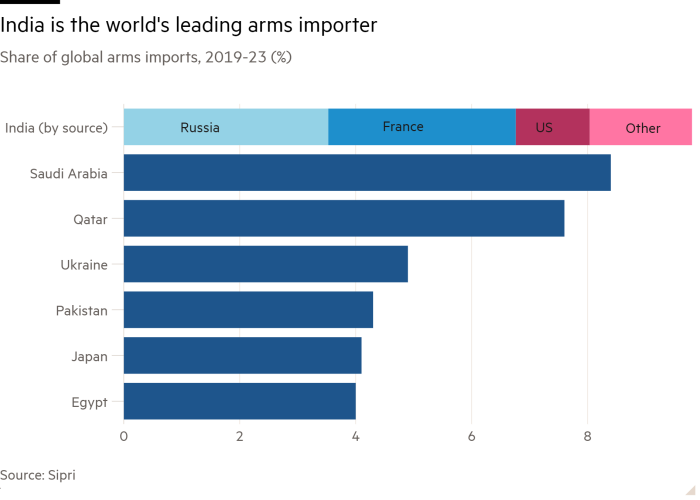
A behind-the-scenes battle is now heating up, involving lobbying, horse-trading, and pledges about future ownership of intellectual property, to become the aerospace partner of choice for the world’s most populous country.
Jostling for the lucrative contract to help India fulfil its ambitions are three key players: General Electric of the US, the UK’s Rolls-Royce, and French group Safran. France and the US are already India’s second and third-biggest defence suppliers after Russia, whose aircraft and other military equipment India is diversifying away from.
Which partner New Delhi chooses would be freighted with geopolitical implications. It comes at a time when India’s international ambitions are rising, its military rivalry with China is deepening, its relationship with the US is expanding and the Modi government is aspiring to join the world’s top tables, including the UN Security Council.
On the table for the three companies — and the governments backing them — is a decades-long partnership across both defence and civil industries with a fast-growing economy, one that will depend on imported knowhow and kit for years to come.
“Part of the attraction is simply one of scale,” says Douglas Barrie, senior fellow for military aerospace at the International Institute for Strategic Studies. “India will over time require considerable numbers of aircraft as the air force looks to recapitalise combat aircraft fleets.”
India, says Philippe Errera, executive vice-president of international and public affairs at Safran, is “hugely important” for the group, “based on the present and looking into the future”.
“This goes beyond military jet engines, to include defence more broadly but also commercial engines,” he adds.
Last year, India managed to land an uncrewed spacecraft near the Moon’s south pole. But despite years of trying, it has yet to develop a viable, advanced military jet engine.
Developing an engine large and powerful enough for a civil jet is already extremely complex, analysts say. It relies on knowledge built up over decades, including which materials to use and why and on how to integrate the different parts.
A military jet engine that is capable of delivering world-class performance on a consistent basis brings with it an extra set of challenges, given the higher speeds and tolerances involved. This helps explain why more countries have nuclear weapons capability than the technology needed to keep a fighter jet in the air.
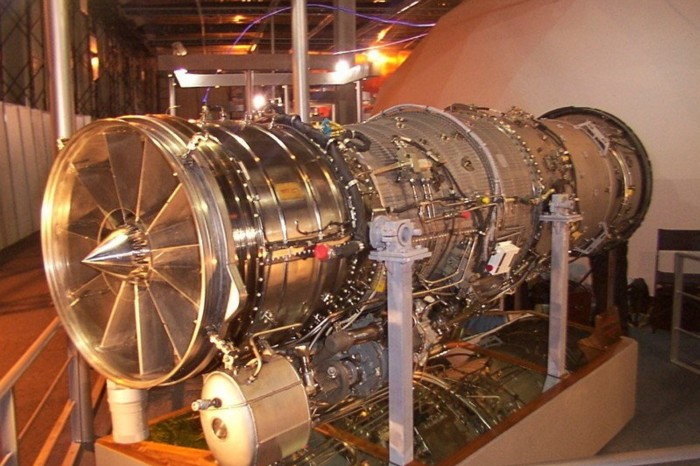
While large civil engines need to maximise fuel efficiency, military jet engines are about the amount of power an engine can produce in relation to weight of the aircraft, analysts say. “No other form of power apart from nuclear comes close to the level of power density you get in a gas turbine,” says one industry expert, who asked not be named because of the sensitivities around discussing large military deals.
Civil airliners fly predictable route patterns and spend much of their time at cruising altitude; military jets have to fly at much higher speeds and with the ability to accelerate quickly. This means, for example, that the bearings in the gas turbine have to be developed to withstand greater tolerances. The engines also use afterburners, which provide a short burst of increased thrust by igniting additional fuel in its exhaust stream.
Complicating things further, most fifth-generation fighters — like the one being mooted by India — will have their engines embedded within the aircraft frame to minimise their radar and infrared signatures to help avoid detection. All these complexities extend the development and certification programme for military engines.
“India has a technology bottleneck which it has to pass through with gas turbines,” says Prasobh Narayanan, a senior aviation analyst at Janes in Bengaluru. “It is not able to crack that bottleneck on its own, and needs help.”
India’s efforts to develop the Kaveri in the 1990s came at a time of acute strategic challenges, after the Soviet Union — its biggest military supplier — collapsed. New Delhi was also at loggerheads with Washington over its nuclear weapons programme, and began developing military ties with alternative suppliers such as France.
The situation today is far different. India has reconciled with the US and over the past two years the two nations have expanded co-operation in defence and technology. This partially reflects a shift in India’s threat perception; it now sees China, and not its neighbour and long-standing foe Pakistan, as the bigger danger.
Since Modi took power in 2014, he has stepped up efforts to bring foreign defence groups to India and promote more “indigenous” production in defence, urging private groups such as Tata, Adani and Mahindra to begin making defence products ranging from personnel carriers to drones.
However, the entry of these Indian conglomerates to the defence market over the past decade have failed to make up for the failings of its state-owned groups, led by Hindustan Aeronautics (HAL), India’s biggest aerospace producer. India’s Defence Research and Development Organisation and HAL are set to be the Indian partner in developing the new jet engine. HAL and India’s ministry of defence did not respond to requests for comment.
India abandoned plans for a “Make in India” project to produce French Rafale jets locally, opting instead to buy 36 imported jets in 2016. Today India also remains its biggest defence importer — not a point of pride for a country that aspires to boost its own industrial exports and create desperately needed jobs. China is going to be “increasingly active in the combat aircraft export market and with its own rather than Russian-sourced engines”, says Barrie of the IISS. But he believes Beijing is unlikely to compete in traditional western markets.
The world’s large aero-engine makers have been active in India for decades, forging partnerships with domestic contractors and setting up local manufacturing. Engines by Rolls-Royce powered the first flight of the Indian Air Force in 1933, while Safran is the leading supplier of turbine engines for the country’s military helicopters.
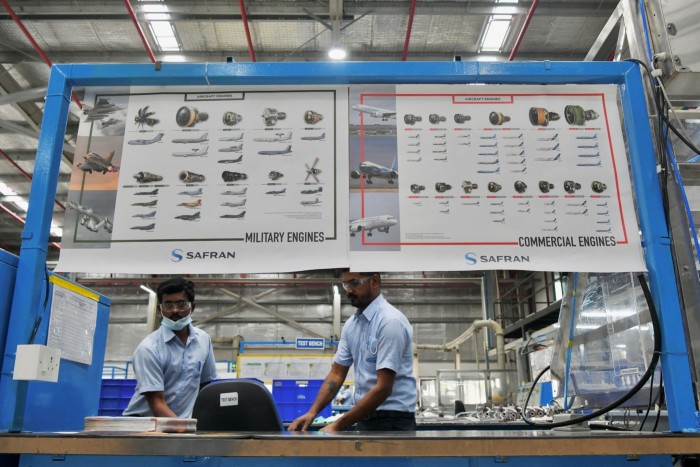
$1.8bn
Amount approved by the government for manufacturing, testing and certifying of five advanced military aircraft prototypes
90 years
Length of Rolls-Royce’s long history in India, involving multiple partnerships across the UK aerospace and defence group’s divisions
3,000
People employed by Safran in India (Bangalore plant, above), a workforce the French group says will increase with its expansion
After the Kaveri engine failed to meet performance criteria, HAL turned to GE engines, and uses the US producer’s F404 models in its first-generation Mk1 fighters.
During Modi’s state visit to Washington last year, GE announced it was ready to supply India with its newer F414 engines for the forthcoming Tejas Mk2. The agreement includes the potential joint production of the F414 engines in India.
GE signalled at the time that it believed that this positioned it well for future work. The US company said it would continue to “collaborate with the Indian government” on the engine programme for the more advanced fighter.
India’s commitment to building its own military jet engine is backed by significant funding. In March, its Cabinet Committee on Security approved funding worth $1.8bn for the manufacturing, testing and certifying of five prototypes for the Advanced Medium Combat Aircraft programme over the next five years.
Indian officials have spoken of inducting the planned jet into the Indian Air Force by the early to mid-2030s, leading to speculation among defence analysts in the country that it will soon decide who its partner on the “indigenous” jet engine will be.
Rolls-Royce and Safran each insist that they are ready to work with HAL, the state-owned aerospace firm, to co-develop a bespoke engine that would entail a full transfer of intellectual property to India, including the right to include it in future exports.
Britain’s Rolls-Royce has emphasised its long history in India, which stretches back more than 90 years and involves multiple partnerships across its divisions.
“What we are talking about is a gear change,” says Alex Zino, director of future programmes for Rolls-Royce’s defence division. “Now is the time to co-create that IP and that capability in-country, so that it is owned in-country.”
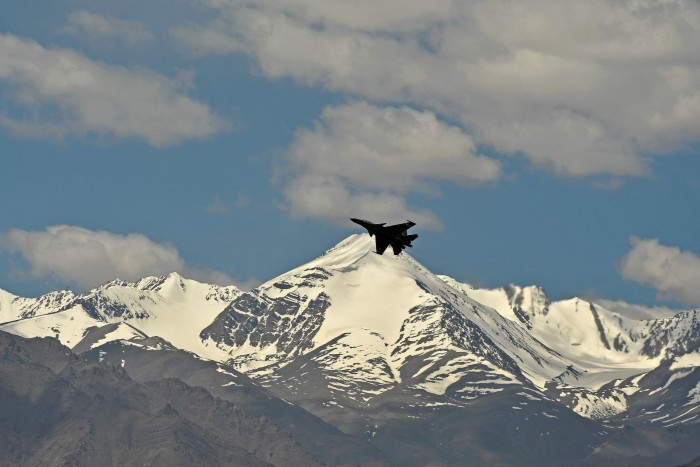
India, Zino says, would have the freedom to operate, upgrade or modify the co-developed engine, should they partner. Rolls-Royce has been working on its proposal “through and with the UK government”, he confirms.
Safran, too, is promising India similar freedoms to own any engine technology it and HAL co-develop. The French company’s proposal would give India “strategic independence in terms of empowering the country to design, develop and produce state of the art military jet engines domestically and export them”, says Errera, the Safran executive.
GE’s offer, by contrast, would withhold a small portion of the IP on any future co-developed jet engine, according to two people familiar with its plans. “Some things the US, from a national security perspective, might want to retain,” says one of the people. GE declined to comment.
Some US officials remain wary of India’s continued close relationship with Russia, analysts say, meaning Washington and GE might be less willing to part ways with coveted technology in its entirety. Although India and the US are co-operating more closely than ever, including on defence, New Delhi retains ties and trading relationships with not only Moscow but other governments, such as Tehran, that are inimical to Washington.
Working in GE’s favour, however, is geopolitics and India’s deepening relationship with the US — part of a joint strategy to build an “Indo-Pacific” bulwark against China. India is already deploying multiple US defence platforms, including helicopters, howitzers, and mobility aircraft, and is in the process of agreeing a major contract for long-endurance UAVs with General Atomics.
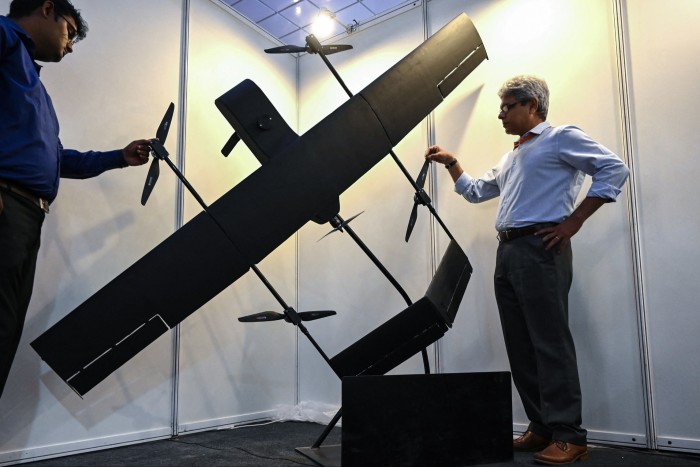
“I think the American offer is the most serious one,” says Amit Cowshish, a retired senior civil servant formerly active in India’s defence ministry. “The Americans could possibly be pushing harder with the kind of clout they have, which is much more than that of any other country.”
France has made an appeal based on its own burgeoning relationship with New Delhi. Safran employs just under 3,000 people in India — a number it says will grow as it expands its operations there. The French group, in which the government holds an 11 per cent share, plans to open a maintenance facility in the aerospace and tech hub of Hyderabad, a city in southern India’s Telangana state, next year. The site will support the Leap engines Safran makes through its CFM International, a joint venture with GE Aerospace, and which power the majority of the Airbus A320 family of commercial jets.
“We have stood by your side through thick and thin,” Safran’s chair Ross McInnes assured an audience at India’s Defence Conclave earlier this month. “The same cannot be said of your other western partners,” he added, noting that France was the only western country that stood with India after the uproar over its nuclear tests in 1998.
Errera echoes the point, saying there is “more predictability and more stability in the relationship” with France than with its rivals. And unlike the US, where Congress needs to sign off on big defence deals, the French government could green light any future co-operation.
India’s government and HAL have given no indication of when they will issue the first “request for information” to potential engine partners.
Although India’s state-dominated defence establishment tends to move slowly, and with limited transparency, analysts and officials say New Delhi will need to quicken its pace if it wants to keep up on defence.
“If they don’t make the decision, soon they will be missing the deadline” for a decision on their engine programme, says Raji Pillai, resident senior fellow with the Australian Strategic Policy Institute, a Canberra-based think-tank. “India’s fighter jet numbers are depleting pretty fast.”